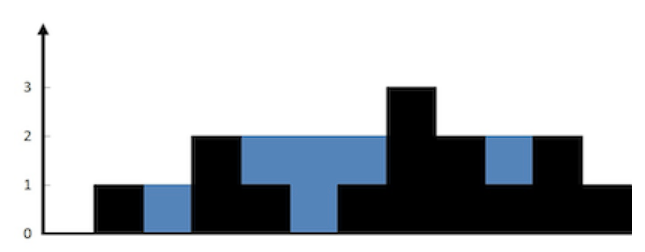[코테] 리트코드 배열 42. Trapping Rain Water
42. Trapping Rain Water
문제 링크
https://leetcode.com/problems/trapping-rain-water/description/
문제 설명
Given n non-negative integers representing an elevation map where the width of each bar is 1, compute how much water it can trap after raining.
제한 사항
- n == height.length
- 1 <= n <= 2 * 104
- 0 <= height[i] <= 105
입출력 예 #1

- Input: height = [0,1,0,2,1,0,1,3,2,1,2,1]
- Output: 6
- Explanation: The above elevation map (black section) is represented by array [0,1,0,2,1,0,1,3,2,1,2,1]. In this case, 6 units of rain water (blue section) are being trapped.
입출력 예 #2
- Input: height = [4,2,0,3,2,5]
- Output: 9
문제 풀이
투포인터 기법 또는 스택 쌓기로 문제 풀이 가능하다.
아직 나한테는 어려운 거 보니 갈 길이 멀다.
## 투 포인터를 최대로 이동
class Solution:
def trap(self, height: List[int]) -> int:
if not height :
return 0
volume = 0
left, right = 0, len(height) - 1
left_max, right_max = height[left], height[right]
while left < right :
left_max, right_max = max(height[left], left_max), max(height[right], right_max)
# 더 높은 쪽을 향해 투 포인터 이동
if left_max <= right_max :
volume += left_max - height[left]
left += 1
else :
volume += right_max - height[right]
right -= 1
return volume
## 스택 쌓기
class Solution:
def trap(self, height: List[int]) -> int:
stack = []
volume = 0
for i in range(len(height)):
# 변곡점을 만나는 경우
while stack and height[i] > height[stack[-1]]:
# 스택에서 꺼낸다.
top = stack.pop()
if not len(stack):
break
# 이전과의 차이만큼 물 높이 처리
distance = i - stack[-1] -1
waters = min(height[i], height[stack[-1]]) - height[top]
volume += distance * waters
stack.append(i)
return volume
Comments